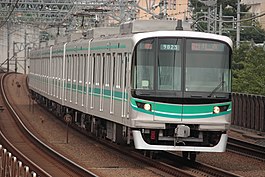This article needs additional citations for
verification. (January 2022) |
| Tokyo Metro Namboku Line | |||
|---|---|---|---|
 | |||
 A Namboku Line
9000 series train | |||
| Overview | |||
| Other name(s) | N | ||
| Native name | 東京メトロ南北線 | ||
| Owner |
| ||
| Line number | 7 | ||
| Locale | Tokyo | ||
| Termini | |||
| Stations | 19 | ||
| Color on map | Teal (#00AC9B) | ||
| Service | |||
| System | Tokyo subway | ||
| Operator(s) | Tokyo Metro | ||
| Depot(s) | Ōji | ||
| Rolling stock | |||
| Daily ridership | 522,736 (2017) [1] | ||
| History | |||
| Opened | 29 November 1991 | ||
| Technical | |||
| Line length | 21.3 km (13.2 mi) | ||
| Number of tracks | Double-track | ||
| Track gauge | 1,067 mm (3 ft 6 in) | ||
| Minimum radius | 160.351 m (526.09 ft) | ||
| Electrification | 1,500 V DC ( overhead catenary) | ||
| Operating speed | 80 km/h (50 mph) | ||
| Train protection system | New CS-ATC, ATO | ||
| Maximum incline | 3.5% | ||
| |||
The Tokyo Metro Namboku Line (東京メトロ南北線, Tōkyō Metoro Nanboku-sen, South-North Line) is a subway line owned and operated by Tokyo Metro in Tokyo, Japan. The line runs between Meguro in Shinagawa and Akabane-Iwabuchi in Kita. The Namboku Line was referred to as Line 7 during the planning stages, thus the seldom-used official name is Line 7 Namboku Line (7号線南北線, Nana-gō-sen Nanboku-sen).
On maps, diagrams and signboards, the line is shown using the color emerald (previously coded "teal"), and its stations are given numbers using the letter "N".
Overview
Trains run through onto the Tokyu Meguro Line for Hiyoshi and the Saitama Railway's Saitama Rapid Railway Line (which is essentially a separately-owned extension of the Namboku Line) for Urawa-Misono.
The right-of-way and stations between Shirokane-Takanawa and Meguro are shared with the Toei Mita Line – a unique situation on the Tokyo subway where both operators share common infrastructure. Under an agreement between Tokyo Metro and the Tokyo Metropolitan Government, the fare for this section is calculated on the Toei fare system for passengers traveling to stations on the Mita Line past Shirokane-Takanawa, on the Metro fare system for passengers traveling to stations on the Namboku Line past Shirokane-Takanawa, and on the system "most beneficial to the passenger" (presently the Metro schedule) for travel solely on the shared sector.
On maps, diagrams and signboards, the Namboku Line is shown using the color emerald (▉), and its stations are given numbers using the letter "N".
Station list
- All stations are located in Tokyo.
- All services stop at all stations.
| Station No. |
Station | Japanese | Distance (km) | Transfers | Location | |
|---|---|---|---|---|---|---|
| Between stations |
From N-01 | |||||
| ↑
Through-running to/from ↑
MG Meguro Line for Hiyoshi SH Tōkyū Shin-yokohama Line for Shin-Yokohama
| ||||||
| N01 | Meguro | 目黒 [* 1] | – | 0.0 |
|
Shinagawa |
| N02 | Shirokanedai | 白金台 [* 2] | 1.3 | 1.3 | I Mita Line (I-02) (shared) | Minato |
| N03 | Shirokane-takanawa | 白金高輪 [* 2] | 1.0 | 2.3 | I Mita Line (I-03) (shared) | |
| N04 | Azabu-juban | 麻布十番 | 1.3 | 3.6 | E Ōedo Line (E-22) | |
| N05 | Roppongi-itchome | 六本木一丁目 | 1.2 | 4.8 | ||
| N06 | Tameike-sanno | 溜池山王 | 0.9 | 5.7 |
|
Chiyoda |
| N07 | Nagatacho | 永田町 | 0.9 | 6.6 |
| |
| N08 | Yotsuya | 四ツ谷 | 1.3 | 7.9 |
|
Shinjuku |
| N09 | Ichigaya | 市ケ谷 | 1.0 | 8.9 |
| |
| N10 | Iidabashi | 飯田橋 | 1.1 | 10.0 |
| |
| N11 | Korakuen | 後楽園 | 1.4 | 11.4 |
|
Bunkyō |
| N12 | Todaimae | 東大前 | 1.3 | 12.7 | ||
| N13 | Hon-komagome | 本駒込 | 0.9 | 13.6 | ||
| N14 | Komagome | 駒込 | 1.4 | 15.0 | JY Yamanote Line | Toshima |
| N15 | Nishigahara | 西ケ原 | 1.4 | 16.4 | Kita | |
| N16 | Oji | 王子 | 1.0 | 17.4 | ||
| N17 | Oji-kamiya | 王子神谷 | 1.2 | 18.6 | ||
| N18 | Shimo | 志茂 | 1.6 | 20.2 | ||
| N19 SR19 | Akabane-iwabuchi | 赤羽岩淵 [* 3] | 1.1 | 21.3 | SR Saitama Railway Line | |
| ↓
Through-running to/from↓
SR Saitama Rapid Railway Line for Urawa-Misono | ||||||
Rolling stock
- Tokyo Metro 9000 series 6/8-car EMUs
- Tokyu 3000 series 8-car EMUs
- Tokyu 5080 series 8-car EMUs
- Tokyu 3020 series 8-car [2] EMUs
- Saitama Rapid Railway 2000 series 6-car EMUs
- Sotetsu 21000 series 8-car EMUs
-
Tokyo Metro 9000 series
-
Saitama Rapid Railway 2000 series
-
Tokyu 3000 series
-
Tokyu 5080 series
-
Tokyu 3020 series
-
Sotetsu 21000 series
History
The 21.3 km (13.2 mi) Namboku Line is one of Tokyo Metro's newer lines, featuring advanced technology including full automatic train operation and platform screen doors. Although the line was originally proposed in 1968, construction did not begin until the 1980s, partly due to the right-of-way to Meguro with the Toei Mita Line. The first segment from Komagome to Akabane-Iwabuchi opened on 29 November 1991.
The line initially operated with four-car EMUs. Upon its extension to Yotsuya in March 1996, the formations were extended to six cars. On 1 April 2022, eight-car trains began operating on the line. [2]
The extension to Tameike-Sannō was completed in September 1997, and the last stretch from Tameike-Sanno to Meguro was completed on 26 September 2000, when through service to the Tokyu Meguro Line started. [3] Through service with the Saitama Rapid Railway Line commenced when it opened in March 2001 and accommodated traffic to and from Saitama Stadium during the 2002 World Cup. Although the Saitama Line is more or less a northern extension of the Namboku Line, it nevertheless remains a private entity to which the Namboku Line offers through services with.
The Namboku Line was inherited by Tokyo Metro after the privatization of the Teito Rapid Transit Authority (TRTA) in 2004. [4]
Effective the timetable revision on 18 March 2023, through services onto the Sagami Railway commenced courtesy of the Tokyu and Sotetsu Shin-Yokohama Line. [5] Most southbound services past Hiyoshi continue as far south as Shin-Yokohama and Ebina.
Future plans
On 28 January 2022, Tokyo Metro announced that a 2.5 km (1.6 mi) spur line from Shirokane-takanawa to Shinagawa would be built. [6] The extension is expected to cost ¥131 billion (2021) ( US$1.19 billion) and scheduled to begin revenue service in the mid-2030s. It is intended to increase connections to and from the Chūō Shinkansen, which is scheduled to open for service in 2027.
References
- ^ Meguro is shared by Toei, Tokyo Metro, and Tokyu Corporation; Tokyu Corporation manages the station.
- ^ a b Shirokanedai and Shirokane-Takanawa are shared by Toei and Tokyo Metro; Tokyo Metro manages both stations.
- ^ Akabane-iwabuchi is shared by Tokyo Metro and Saitama Rapid Railway; Tokyo Metro manages the station.
- Shaw, Dennis and Morioka, Hisashi, "Tokyo Subways", published 1992 by Hoikusha Publishing
- ^ Tokyo Metro station ridership in 2017 Train Media (sourced from Tokyo Metro) Retrieved July 23, 2018.
- ^ a b 東急目黒線・東京メトロ南北線・埼玉高速鉄道線で8両編成の運転開始 [8-car trains begin operating on the Tokyu Meguro Line, Tokyo Metro Namboku Line, and Saitama Rapid Railway Line]. Japan Railfan Magazine Online (in Japanese). Japan: Koyusha Co., Ltd. 9 April 2022. Retrieved 27 May 2022.
- ^ "開業区間の運賃及び相互直通運転に伴う運行形態を決定". tokyometro.go.jp. 30 August 2000. Archived from the original on 17 December 2003. Retrieved 29 January 2024.
- ^ "「営団地下鉄」から「東京メトロ」へ" [From "Teito Rapid Transit Authority" to "Tokyo Metro"]. Tokyo Metro Online. 8 July 2006. Archived from the original on 16 May 2012. Retrieved 29 May 2022.
- ^ "~神奈川県央地域及び横浜市西部から東京・埼玉に至る広域的な鉄道ネットワークの形成~" [-Formation of a wide-area railway network from central Kanagawa Prefecture and western Yokohama to Tokyo and Saitama-] (PDF). tokyometro.jp. 27 January 2022. Archived from the original (PDF) on 27 January 2022. Retrieved 22 March 2023.
- ^ "有楽町線延伸(豊洲・住吉間)及び南北線延伸(品川・白金高輪間)の鉄道事業許可を申請しました。" [Yurakucho Line extension (between Toyosu and Sumiyoshi) and Namboku Line extension (between Shinagawa and Shirokane Takanawa) application for a Business Permit] (PDF). Tokyo Metro (in Japanese). 28 January 2022. Retrieved 28 January 2022.






